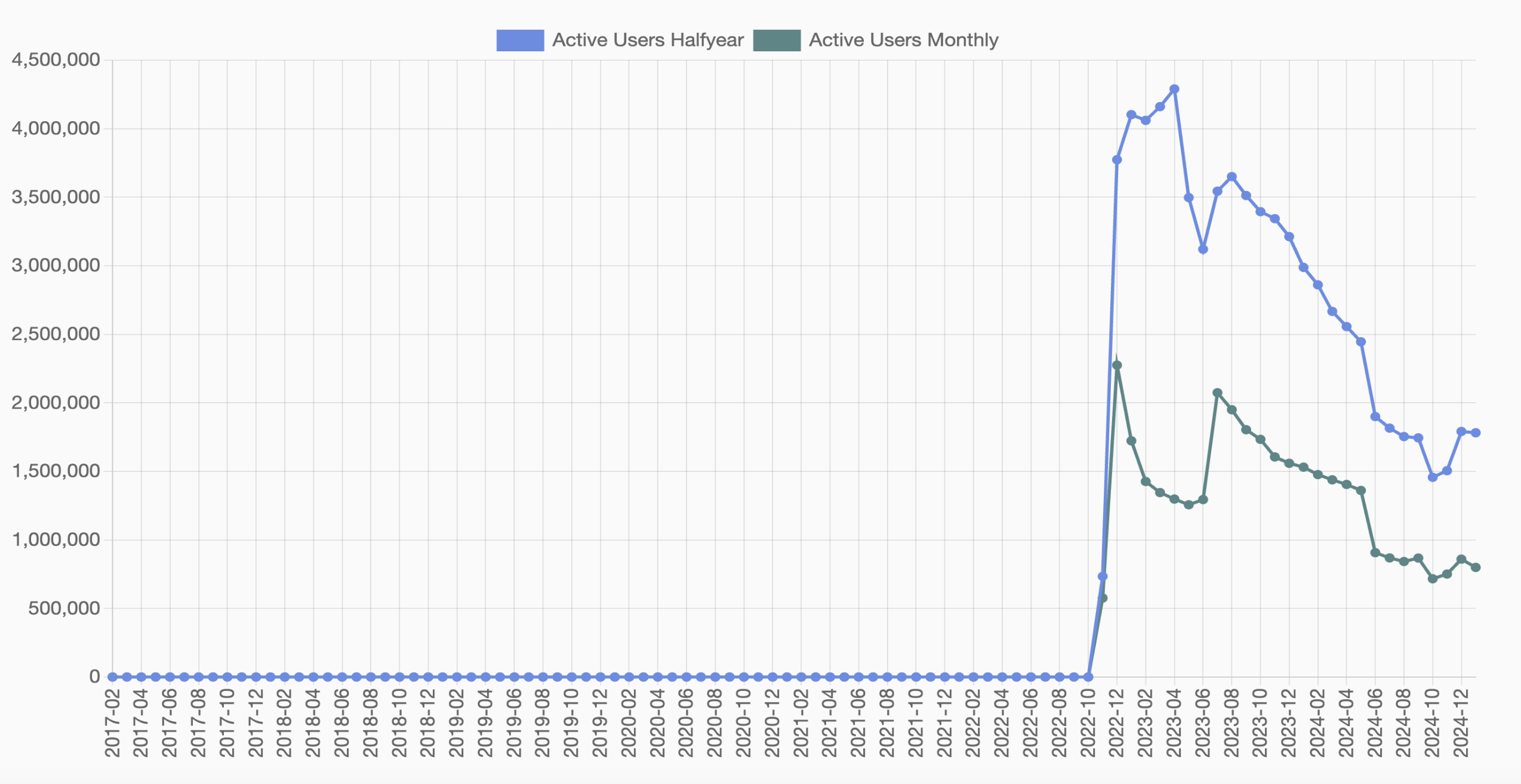A few years ago, I published an essay about the Fediverse and the potential land grab by large corporations like Medium, Meta, and others. This was in response to the first wave of destruction Elon Musk unleashed on Twitter, prompting a massive exodus of users.
These corporations aimed to capitalize on capturing those users for profit. Did it work? I’m not so sure.
Medium is still running me.dm, but it has only 2,000 active users. Meanwhile, Mastodon, the cornerstone of the Fediverse, has seen a decline in active users since its peak in late 2022 and early 2023.

So what’s going on? While I can’t claim to know all the reasons users drifted away from Mastodon, I suspect it has a lot to do with the absence of an engagement algorithm.
Let’s face it: engagement algorithms are like crack—insidious and addictive. They hook us with the rush of validation, whether it’s an article being boosted or a TikTok video going viral. That fleeting sense of recognition makes us feel seen, like what we say truly matters.
The lack of such algorithms is why I moved Weathered to Medium and my From the Desk of Thomas Ott site to Substack. For the first time in a long while, I began to see engagement, comments, and viewership.
This shift led to explosive growth. Over the last two months, I saw a surge in subscribers to The Weathered Publication and followers of my work on Medium. It felt good—great, even—to be recognized for years of effort.
But despite this success, I started to feel empty. By the end of 2024, I hit a philosophical wall: how real was all this? Did my new readers and followers truly resonate with my work, or was it just another blip on their screen, grabbing their fleeting six seconds of attention?
This existential question gnawed at me, and for the first time in a long while, I turned back to the Fediverse, embarking on a kind of siloed social media rehab.
The Fediverse is inherently designed to wrest power away from corporations and place it back in the hands of individuals. In that sense, it’s succeeding. Without engagement algorithms artificially boosting content, the Fediverse avoids the noise that plagues platforms like Medium and Substack. The tollgates of those platforms—paywalls and subscription models—don’t translate well here.
This makes the Fediverse unprofitable for corporations and less appealing to users chasing metrics like views and likes. Platforms like Medium, Substack, Twitter, and their ilk thrive on siloing users into their ecosystems, mining data, and selling ads.
We, the happy cows, walk willingly to the slaughterhouse, mooing all the way.
Years ago, Dmitri of deoxy.org (mirrored site here) fame shared an excerpt from Adam Curtis that still resonates today:
“On Facebook and Twitter, you are performing to attract people—you are dancing emotionally, on a platform created by a large corporation.
People’s feelings bounce back and forth, ignoring and denying the system of power.
It’s like Stalin’s socialist realism.
Both Twitter and socialist realism are innocent expressions of the ideology of the time, which don’t pull back and show the wider thing they are part of.
I think sometime in the future people will look back at the millions and millions of descriptions of personal feelings on the internet and see them in similar ways.
This is the driving belief of our time: that ‘me’ and what I feel minute by minute is the natural center of the world.
Far from revealing that this is an ideology—and that there are other ways of looking at human society—what Twitter and Facebook do is reinforce the feeling that this is the natural way to be.”
Curtis’s words capture the performative nature of social media. While I once loved Twitter—addicted, really—it has devolved under Musk into a dangerous platform for misinformation and conspiracies. Pre-Musk, Twitter made efforts to curb false information; now, it actively promotes it.
This siloing of thoughts, ideas, and data has fragmented our society. It’s a classic “divide and conquer” strategy, driven by profit motives. As I wrote in The Weathered Publication:
“The siloing of thought, ideas, and data has led us to a more divisive society and world. It’s a ‘divide and conquer’ strategy with the ultimate goal to make money.”
If Twitter were an organism, Musk would be the virus putting it in intensive care. The prognosis is grim.
Looking back over the past two years, it’s clear the land grab played out differently than I expected. Yes, corporations like Meta and WordPress integrated ActivityPub protocols into their software, but their platforms still prioritize profit over people.
The Fediverse, by contrast, is a truly grassroots, “power to the people” environment. It’s organic, decentralized, and free from the engagement-driven tactics that create division. If your post resonates there—be it a photo, an article, or anything else—it’s because it connects authentically, not because an algorithm decided to amplify it.
For me, the Fediverse is a refuge from the noise—a place to engage meaningfully, free from the hollow validation of metrics. It’s not about chasing numbers or performing for an audience. It’s about connection, community, and a more equitable digital future.
And that’s why I believe the Fediverse will save us.
